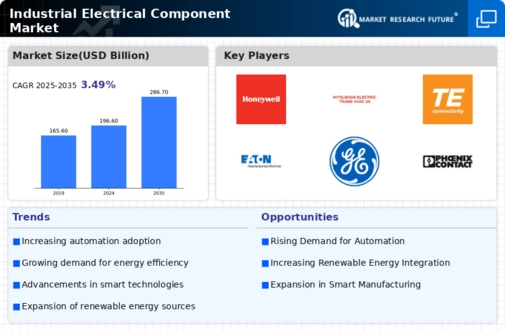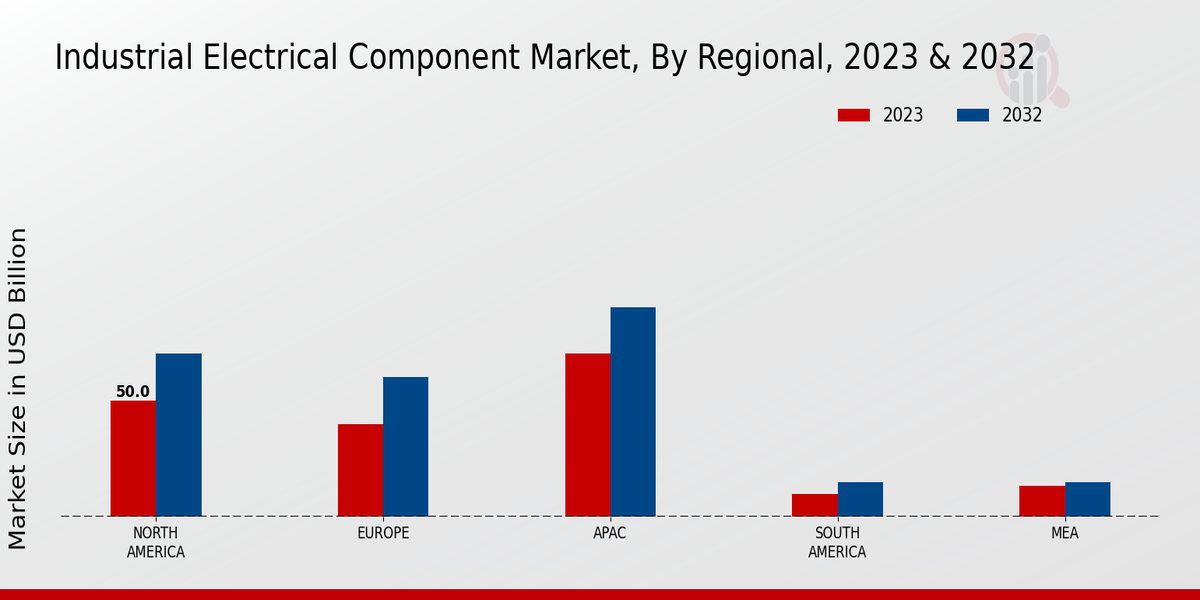Market Growth Projections
The Global Industrial Electrical Component Market Industry is projected to experience substantial growth over the coming years. With a market size anticipated to reach 196.6 USD Billion in 2024 and further expand to 286.7 USD Billion by 2035, the industry is on a promising trajectory. This growth is underpinned by various factors, including rising automation, renewable energy investments, and technological advancements. The expected CAGR of 3.49% from 2025 to 2035 indicates a robust demand for industrial electrical components, driven by the ongoing transformation of industrial processes and infrastructure.
Rising Demand for Automation
The Global Industrial Electrical Component Market Industry experiences a notable surge in demand for automation technologies across various sectors. Industries such as manufacturing, oil and gas, and utilities are increasingly adopting automated systems to enhance operational efficiency and reduce labor costs. This trend is projected to drive the market's growth, with the market size expected to reach 196.6 USD Billion in 2024. Automation not only streamlines processes but also improves safety and reliability, making it a pivotal factor in the industry's evolution.
Growth in Renewable Energy Sector
The Global Industrial Electrical Component Market Industry is significantly influenced by the expansion of the renewable energy sector. As countries worldwide commit to reducing carbon emissions, investments in solar, wind, and other renewable energy sources are escalating. This shift necessitates advanced electrical components for energy generation, distribution, and storage. The market is likely to benefit from this trend, as the integration of renewable energy systems requires sophisticated electrical components to ensure efficiency and reliability. By 2035, the market could reach 286.7 USD Billion, reflecting the growing importance of sustainable energy solutions.
Increased Focus on Energy Efficiency
The Global Industrial Electrical Component Market Industry is witnessing a heightened focus on energy efficiency as industries strive to reduce operational costs and environmental impact. Companies are increasingly adopting energy-efficient electrical components to comply with regulations and meet sustainability targets. This trend is evident in sectors such as manufacturing and transportation, where energy consumption is a significant concern. The push for energy efficiency not only drives innovation in component design but also fosters a competitive market landscape. As a result, the industry is poised for growth, reflecting the global shift towards sustainable practices.
Infrastructure Development Initiatives
Infrastructure development initiatives across the globe are a significant driver for the Global Industrial Electrical Component Market Industry. Governments are investing heavily in upgrading and expanding infrastructure, including transportation, utilities, and communication systems. This investment necessitates a wide range of electrical components for construction, operation, and maintenance. For example, smart grid technologies require advanced electrical components to enhance energy distribution and management. As infrastructure projects progress, the demand for industrial electrical components is likely to increase, further propelling market growth.
Technological Advancements in Electrical Components
Technological advancements play a crucial role in shaping the Global Industrial Electrical Component Market Industry. Innovations in materials, design, and manufacturing processes lead to the development of more efficient and reliable electrical components. For instance, the introduction of smart sensors and IoT-enabled devices enhances monitoring and control capabilities in industrial applications. These advancements not only improve performance but also reduce energy consumption, aligning with global sustainability goals. As a result, the market is expected to grow at a CAGR of 3.49% from 2025 to 2035, driven by the continuous evolution of technology.






















